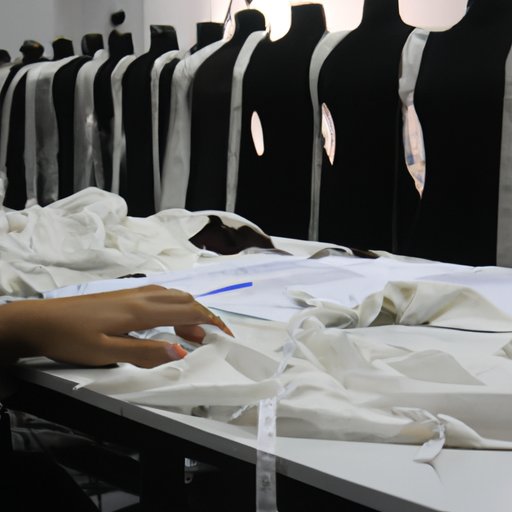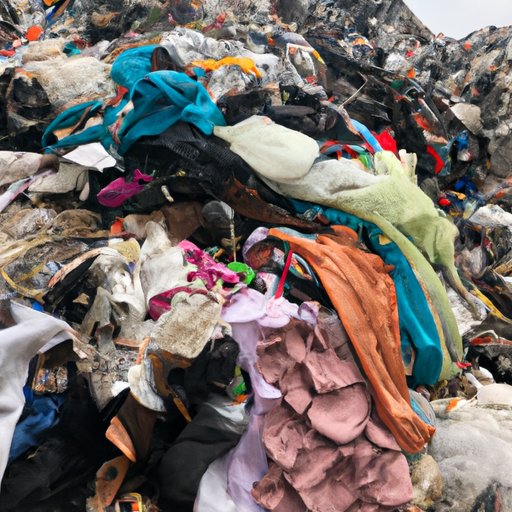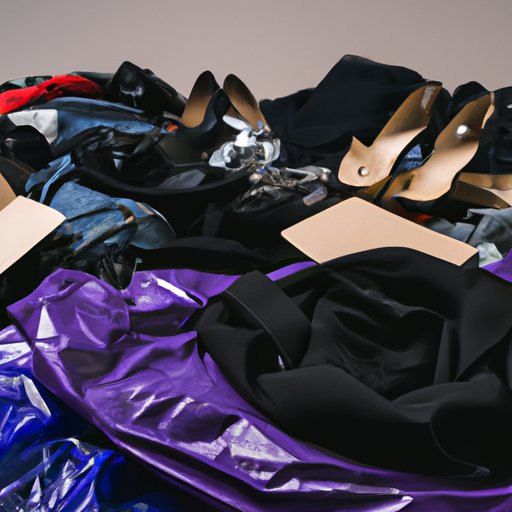Introduction
The fashion industry is a booming business all over the world. It is estimated that the global apparel market is worth more than $3 trillion and is expected to grow even further in the coming years. While the fashion industry has brought much economic growth and opportunity, it has also caused many problems along the way. From unethical labor practices to excessive waste and lack of diversity and representation, the fashion industry has a lot of issues that need to be addressed. In this article, we will explore the various problems in the fashion industry and discuss potential solutions.

Exploring Unethical Labor Practices in the Fashion Industry
Unethical labor practices are one of the most common problems in the fashion industry. These practices involve exploiting workers for their labor, often through low wages, long hours, and unsafe working conditions.
Definition of Unethical Labor Practices
Unethical labor practices refer to any labor practices that exploit workers or violate their rights. This includes denying workers fair wages, providing inadequate safety measures, or forcing them to work in dangerous conditions. Unethical labor practices also include child labor and forced labor.
Examples of Unethical Labor Practices
Unethical labor practices can be found in many different parts of the world. For example, in India and Bangladesh, many garment factories employ children to work long hours for extremely low wages. In China, some factories have been accused of using forced labor, where workers are forced to work without pay or under threat of violence. In the United States, there have been reports of sweatshops, where workers are paid very little and are not given proper safety equipment.
Impact of Unethical Labor Practices
Unethical labor practices have a negative impact on both workers and consumers. Workers are exploited and denied their basic rights, while consumers are left unaware of the unethical practices taking place in the production of their clothing. This can lead to a lack of trust between consumers and the fashion industry, as well as an increased demand for ethical and sustainable fashion.
The Impact of Fast Fashion on the Environment
Fast fashion is another major problem in the fashion industry. Fast fashion refers to the rapid production of inexpensive clothing in order to meet the latest trends. While fast fashion is convenient for consumers, it can have a devastating impact on the environment.
Definition of Fast Fashion
Fast fashion refers to the process of quickly producing large quantities of inexpensive clothing in order to meet the latest trends. This type of fashion is designed to be disposable, meaning it is meant to be worn only once or twice before being thrown away.
Examples of Fast Fashion’s Impact
Fast fashion has several negative impacts on the environment. The production of fast fashion generates large amounts of waste, as well as air and water pollution. It also uses large amounts of energy and resources, such as water and chemicals, which can harm the environment. Additionally, fast fashion contributes to climate change by releasing greenhouse gases into the atmosphere.
Solutions for Reducing Fast Fashion’s Environmental Impact
There are several ways to reduce the environmental impact of fast fashion. Consumers can choose to buy fewer items and invest in higher quality pieces that will last longer. They can also choose to shop secondhand or rent clothing instead of buying new. Companies can take steps to reduce their environmental impact, such as using sustainable materials, reducing water and energy use, and implementing recycling programs.
Exploring the Negative Effects of Sizeism in Fashion
Sizeism is another major problem in the fashion industry. Sizeism is the practice of discriminating against people based on their body size or shape. This can include excluding certain sizes from collections, using only thin models in advertisements, and using derogatory language to describe larger bodies.
Definition of Sizeism
Sizeism is the practice of discriminating against people based on their body size or shape. This can include excluding certain sizes from collections, using only thin models in advertisements, and using derogatory language to describe larger bodies. Sizeism is a form of discrimination and should not be tolerated in any industry.
Examples of Sizeism in the Fashion Industry
Sizeism is prevalent in the fashion industry. Many companies only offer small or extra-small sizes, while others use only thin models in their advertising campaigns. Some designers have even gone so far as to make derogatory comments about larger bodies, which perpetuates negative stereotypes about body size.
Impact of Sizeism
Sizeism has a negative impact on both the individuals affected by it and society as a whole. On an individual level, sizeism can lead to feelings of shame, insecurity, and isolation. On a larger scale, sizeism reinforces unhealthy beauty standards and contributes to body image issues in young people. It also sends the message that certain bodies are not worthy of respect or representation, which can be damaging to self-esteem.

Excessive Waste in the Fashion Industry
Excessive waste is another major problem in the fashion industry. The production of clothing generates large amounts of waste, from fabric scraps to packaging materials. This waste often ends up in landfills, where it can take hundreds of years to decompose.
Definition of Excessive Waste
Excessive waste refers to any waste that is created during the production of clothing. This includes fabric scraps, packaging materials, and any other materials used in the manufacturing process.
Examples of Excessive Waste in the Fashion Industry
The fashion industry produces a large amount of waste, from fabric scraps to packaging materials. This waste often ends up in landfills, where it can take hundreds of years to decompose. Additionally, the production of synthetic fabrics such as polyester and nylon can release microplastics into the environment, which can harm wildlife and contaminate the food chain.
Solutions to Reduce Excessive Waste
There are several ways to reduce excessive waste in the fashion industry. Companies can switch to using sustainable materials, such as organic cotton or recycled fabrics. They can also implement recycling programs for fabric scraps and packaging materials. Consumers can also help reduce waste by purchasing fewer items and investing in higher quality pieces that will last longer.
Exploring the Lack of Diversity and Representation in the Fashion Industry
The fashion industry has a long history of lacking diversity and representation. This can include using only white models in advertising campaigns, failing to represent different body types, and excluding certain cultures from fashion collections.
Definition of Diversity and Representation
Diversity and representation refer to the inclusion of people from different backgrounds in the fashion industry. This includes people of different races, genders, body types, sexual orientations, and abilities. Representation is important because it allows people to see themselves represented in fashion, which can be empowering and inspiring.
Examples of Lack of Diversity and Representation in the Fashion Industry
The fashion industry has a long history of lacking diversity and representation. This can include using only white models in advertising campaigns, failing to represent different body types, and excluding certain cultures from fashion collections. Additionally, many fashion companies fail to hire diverse teams or provide adequate support to marginalized communities.
Impact of Lack of Diversity and Representation
The lack of diversity and representation in the fashion industry can have a negative impact on both individuals and society as a whole. On an individual level, it can lead to feelings of exclusion and marginalization. On a larger scale, it can contribute to the continued oppression of marginalized communities and reinforce unrealistic beauty standards.

The High Cost of Luxury Brands and its Impact on Consumers
Luxury brands are another problem in the fashion industry, as they often come with a high price tag. Luxury brands are known for their high quality materials and craftsmanship, but they can be unaffordable for many consumers. This can lead to financial strain and debt, as well as a feeling of exclusion from the fashion industry.
Definition of Luxury Brands
Luxury brands are high-end fashion brands that are known for their quality materials and craftsmanship. These brands often come with a hefty price tag, as they use expensive materials and employ skilled artisans to create their products.
Examples of Luxury Brands and Their Impact on Consumers
Luxury brands can have a negative impact on consumers, as they often come with a high price tag. This can lead to financial strain and debt, as well as a feeling of exclusion from the fashion industry. Additionally, luxury brands often employ unethical labor practices in order to keep their costs down, which can further contribute to the exploitation of workers.
Solutions for Reducing the Cost of Luxury Brands
There are several ways to reduce the cost of luxury brands. Companies can switch to using sustainable materials, such as organic cotton or recycled fabrics, which can reduce their production costs. They can also implement fair labor practices to ensure that workers are paid a fair wage. Consumers can also help by choosing to buy secondhand or rent clothing instead of buying new.

Exploring Gender Discrimination in the Fashion Industry
Gender discrimination is another major problem in the fashion industry. This can include unequal pay, limited career opportunities, and sexist language and imagery. Gender discrimination is a form of oppression and should not be tolerated in any industry.
Definition of Gender Discrimination
Gender discrimination is the practice of treating someone differently based on their gender. This can include unequal pay, limited career opportunities, and sexist language and imagery. Gender discrimination is a form of oppression and should not be tolerated in any industry.
Examples of Gender Discrimination in the Fashion Industry
Gender discrimination is rampant in the fashion industry. Women often face unequal pay and limited career opportunities, while men are often favored for higher-level positions. Additionally, female models are often objectified and used to sell products, while male models are rarely seen in fashion campaigns.
Impact of Gender Discrimination
Gender discrimination can have a negative impact on both individuals and society as a whole. On an individual level, it can lead to feelings of frustration and helplessness. On a larger scale, it can contribute to the oppression of women and reinforce gender stereotypes.
Conclusion
The fashion industry has many problems that need to be addressed, from unethical labor practices to excessive waste and lack of diversity and representation. Additionally, luxury brands and gender discrimination are also major issues in the fashion industry. In order to create a more ethical and sustainable industry, companies must take steps to reduce their environmental impact, promote diversity and representation, and ensure fair labor practices. Consumers can also play a role by choosing to buy fewer items and investing in higher quality pieces that will last longer.
Summary of Major Points
The fashion industry has many problems, including unethical labor practices, fast fashion, sizeism, excessive waste, lack of diversity and representation, luxury brands, and gender discrimination. Companies must take steps to reduce their environmental impact, promote diversity and representation, and ensure fair labor practices. Consumers can also help by buying fewer items and investing in higher quality pieces that will last longer.
Final Thoughts
The fashion industry has a lot of issues that need to be addressed, from unethical labor practices to excessive waste and lack of diversity and representation. However, with the right steps, these issues can be resolved and the fashion industry can become more ethical, sustainable, and inclusive.
(Note: Is this article not meeting your expectations? Do you have knowledge or insights to share? Unlock new opportunities and expand your reach by joining our authors team. Click Registration to join us and share your expertise with our readers.)
